Puppies start showing affection as early as a few weeks old. However, the timing depends on their personalities, socialisation, and bond with their owners. Most puppies develop increasing affection as they grow and form stronger emotional connections with their owners.
Just as with us humans, puppies go through emotional development as they grow. In their first year they learn what they like, what feels safe, and who and how to love.
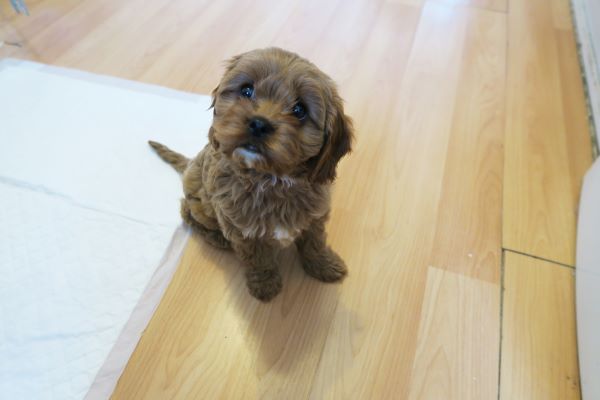
When they’re 4-5 weeks old, they are ready to interact with humans and start developing life and social skills from their mother and littermates.
Puppies start developing emotions when their about two months old, so at around 8 weeks old they will start forming bonds with humans. It certainly didn’t take me months to adore my Cavapoo Bean, but it takes our pups a little time.
Table of Contents
- Breeder Bond with puppies
- Amazing bonding story
- Eighth week collection
- Will my puppy grow to be more affectionate?
- Why is my puppy not cuddly?
- Tips for getting your dog to show more affection
- Frequently Asked Questions: When Do Puppies Become Affectionate?
- 1. At what age do puppies become affectionate?
- 2. Do all puppies become affectionate?
- 3. How can I help my puppy become more affectionate?
- 4. Will my puppy become more affectionate with age?
- 5. What are some signs that my puppy likes to cuddle?
- 6. What if my puppy doesn't want to cuddle?
- 7. Can I train my puppy to be more affectionate?
- 8. Why is it important to be affectionate with my puppy?
- Wrap up of: When do puppies become affectionate
Breeder Bond with puppies
Puppy farms that produce puppies on a conveyor belt and pop them out like shelling peas tend not to build up any bond with the pups as they are just a commodity to them. However a family pet who is loved member of the family who has a litter well that's a different story.
Those pups will get love and attention from the family and start to build a bit of a bond in the early weeks.
This makes it harder for the family to part with the pups but the puppy you buy from this type of breeder will have started to develop an ability to give affection, and will already be developing social skills. They will feel a bit sadder when parted from the initial family unit, but will bond quicker with you as they start to rely on you.
Amazing bonding story
The bond with a puppy is weird and my dad told me a story about a litter of pups his mom and dad (Don and Brenda) bred many years ago when he was about 8 years old. They were Dobermann's, who are adorable as pups but can look a bit scary when fully grown.
Obviously as a child he played and petted with the pups (eight of them) up until they left for their new homes at 8 weeks.
Here's the amazing part of the story, about 3 years later having not seen any of the pups in the intervening years he was walking down the road with his friends about 6 of them when they met coming the other way a lady with a full grown Doberman.
As they passed and bearing in mind he was in a group of 6, the Dobermann launched himself at my dad jumping up into his face and was licking him like crazy and making mad yelping noises.
Not yelping in pain but in joy as he literally tried to jump up into my dads arms or wrap himself around his legs. The woman struggled to get the dog under control.
When the Doberman finally calmed down enough that the lady could relax and try to apologise to my dad she had a look at my dad and said "Are you Don and Brenda's son?" The lady was one of the 8 people who'd bought one of the pups three years earlier.
It turned out that this Dobermann, who hadn't seen him for 3 years from when he was 8 weeks old, recognised his "smell" and knew instantly who he was. So don't underestimate the bond you can build up with a puppy in a short space of time when they're young.
Eighth week collection
Normally of course if you're buying a puppy from a breeder you won't pick them up till they are 8 weeks old, so that is a good age for you and them to start forming a bond.
In the rest of this piece, I’ll take you through the early bonding process, give some tips on how to get your pup to be more affectionate, and even look at why some pup’s may not be cuddly. Above all, though, we’ll learn when puppies start to show affection.
Will my puppy grow to be more affectionate?
While there’s no definite age at which puppies begin to show affection, you can help your dog learn to enjoy affection, and pick a breed that’s known for their love of snuggling. Bean sure loves his cuddles!
There are some general stages most dogs go through on their journey to emotional maturity. Let’s look at the bonding process.
- Three months old - By the age of three months, pup’s start to experience emotions like fear and joy. This is when they will form the strongest bonds with their human owners, so it’s crucial to make sure they have positive experiences with you. This is also when experiences — both bad and good — can have a lasting impact on them. So be sure to give your pup many positive, comfortable, fun experiences like meeting new people, and animals and exposing him/her to different environments. Read “Do Cavapoos get on well with cats?”
- Four to five months old – By now, you pup will have a distinct personality and their very own character. They will start to become more curious, independent, and confident as they grow. The more you socialise and bond with your pup at this stage, the closer your bond will become. You might even choose to take your pooch along to a puppy play group for some fun.
- Six to ten months old - Your dog is now officially a teenager, so naturally he/she will begin to test boundaries. It’s important to keep socialising your pup at this stage, to avoid him/her developing defensive or fearful responses to other dogs. Be sure to give them plenty of exercise and training.
- Eleven to twelve months - Your pup will reach emotional maturity somewhere between 1 year to 1½ years old. Smaller dogs tend to reach emotional maturity faster than bigger dogs do. They can now feel happiness, anger. fear and love, along with a plethora of other emotions. If you continue to lavish your pup with attention, showing them love and positive experiences the bond between you will last a lifetime.
Next, let’s look at why some dogs might not be as inclined to cuddle.
Why is my puppy not cuddly?
If you have a rescue dog, or if they were adopted, they may have developed trust issues because their previous owners neglected or abused them. There may be other, more innocent reasons, though.
They may simply:
- Enjoy their own space.
- Be territorial and show affection to a particular member of the family, so it may take them time to warm up to different people.
- Show affections in ways other than cuddling. They may find different, unique ways to show their love.
Tips for getting your dog to show more affection
Dogs, like humans, are all different, and some will be more independent and less fond of snuggling and cuddling.
Nevertheless, there are things you can do to encourage affection.
- Training and positive reinforcement - Using positive reinforcement from an early stage can strengthen the bond and influence how they act towards you and it’s a good way to establish affectionate behaviour between you and your pup.
- Be consistent and positive - Show your pup affection regularly and ensure he/she has lots of positive associations with you, so that you are trustworthy in your dog’s eyes. If your dog trusts you, he or she will feel safe and happy with you.
- Provide your dog with structure – Dogs love routine, so to make your bond even stronger make time for play, exercise, eating, rest, and relaxation.
- Be patient and understanding - Puppies go through different developmental stages and can be stubborn at times. Be patient and understanding so you can encourage positive behaviours rather than focusing on what your pup does wrong.
Frequently Asked Questions: When Do Puppies Become Affectionate?
1. At what age do puppies become affectionate?
Most puppies start to show affection between the ages of 4 and 6 months old. However, some puppies may start to cuddle and snuggle earlier, and some may take a bit longer to warm up to human affection.
2. Do all puppies become affectionate?
While most puppies do become affectionate with their owners, there are individual differences in personality and breed. Some breeds, like the Golden Retriever, are known to be particularly friendly and cuddly while others may be more aloof.
3. How can I help my puppy become more affectionate?
Cuddling and spending quality time with your puppy is a great way to promote bonding and affection. Praise and positive reinforcement can also help to reinforce positive behaviours like cuddling and snuggling.
4. Will my puppy become more affectionate with age?
Yes, many puppies become more affectionate with age as they bond with their owners and become more comfortable with physical touch.
5. What are some signs that my puppy likes to cuddle?
If your puppy likes to cuddle, they may seek out physical touch, lean on you, and snuggle up in your lap. They may also wag their tail and show excitement when they see you.
6. What if my puppy doesn't want to cuddle?
Some puppies may not be naturally inclined to cuddle or may need more time to warm up to physical touch. It's important to be patient and not force physical affection on your puppy. Instead, try to build up trust and bond with your puppy gradually over time.
7. Can I train my puppy to be more affectionate?
While you can't necessarily train your puppy to be affectionate, you can encourage positive behaviours like cuddling and snuggling through praise and positive reinforcement.
8. Why is it important to be affectionate with my puppy?
Show affection to your puppy is a great way to build trust and bond with them. It can also improve their socialisation and overall happiness.
Wrap up of: When do puppies become affectionate
So, there you have it. Puppies start to show affection towards humans at around 8 weeks old, with the next few months of their lives being crucial for developing a strong bond with their owners.
Remember, all dogs are different and have different personalities, but if you follow the advice given here and socialise your pup well, you’ll be setting your pup up for a healthy, happy life, in which you can both enjoy lots of affectionate cuddles.
If you enjoyed this piece, be sure to check out “Are Cavapoos good with kids.”
Here are the latest posts in the "Puppy" section of my blog.
- Can Puppies Look Like Their Grandparents? Unravelling the Mystery!
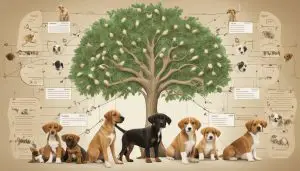 Have you ever noticed a striking resemblance between your new puppy and their grandparents? Perhaps they share the same colouring or have similar facial features? It's not uncommon for puppies to resemble their grandparents, and in this article, I will explore the fascinating topic of whether this is possible and why it happens. We will… Read more: Can Puppies Look Like Their Grandparents? Unravelling the Mystery!
Have you ever noticed a striking resemblance between your new puppy and their grandparents? Perhaps they share the same colouring or have similar facial features? It's not uncommon for puppies to resemble their grandparents, and in this article, I will explore the fascinating topic of whether this is possible and why it happens. We will… Read more: Can Puppies Look Like Their Grandparents? Unravelling the Mystery! - When Do Puppies Require Less Supervision? A Detailed Guide.
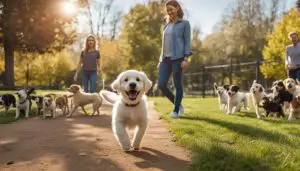 As a new puppy owner, it's important to keep a close eye on your furry friend. Puppies are curious and energetic, which means they require constant supervision to stay safe. However, as your puppy grows and develops, they will start to become more independent and require less supervision. But when exactly do puppies require less… Read more: When Do Puppies Require Less Supervision? A Detailed Guide.
As a new puppy owner, it's important to keep a close eye on your furry friend. Puppies are curious and energetic, which means they require constant supervision to stay safe. However, as your puppy grows and develops, they will start to become more independent and require less supervision. But when exactly do puppies require less… Read more: When Do Puppies Require Less Supervision? A Detailed Guide. - Can Puppy Eat Salmon? – A Friendly Guide to Feeding Puppies
 Welcome to our friendly guide on whether it is safe for a puppy to eat salmon. As a pet owner, you want to ensure that your furry friend is receiving the best possible nutrition to support their well-being. Salmon is a nutritious fish that provides several health benefits for dogs, but is it safe for… Read more: Can Puppy Eat Salmon? – A Friendly Guide to Feeding Puppies
Welcome to our friendly guide on whether it is safe for a puppy to eat salmon. As a pet owner, you want to ensure that your furry friend is receiving the best possible nutrition to support their well-being. Salmon is a nutritious fish that provides several health benefits for dogs, but is it safe for… Read more: Can Puppy Eat Salmon? – A Friendly Guide to Feeding Puppies - Carrots for Puppies Teething: A Natural Solution for Pain Relief
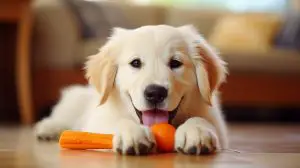 When your little furry friend is going through the teething process, it can be a challenging time for both of you. Thankfully, there are natural remedies that can help relieve their pain while promoting overall health. One such remedy is carrots for puppies teething. Carrots are an excellent source of vitamins and minerals that can… Read more: Carrots for Puppies Teething: A Natural Solution for Pain Relief
When your little furry friend is going through the teething process, it can be a challenging time for both of you. Thankfully, there are natural remedies that can help relieve their pain while promoting overall health. One such remedy is carrots for puppies teething. Carrots are an excellent source of vitamins and minerals that can… Read more: Carrots for Puppies Teething: A Natural Solution for Pain Relief - How long do puppies need milk?
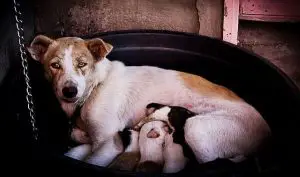 Puppies typically need milk as their primary source of nutrition until they are around 4 to 6 weeks old. After that, they can gradually transition to solid food, but it's essential to consult a vet for guidance on the appropriate time to introduce solids to ensure the puppies' needs are met. Welcoming a litter of… Read more: How long do puppies need milk?
Puppies typically need milk as their primary source of nutrition until they are around 4 to 6 weeks old. After that, they can gradually transition to solid food, but it's essential to consult a vet for guidance on the appropriate time to introduce solids to ensure the puppies' needs are met. Welcoming a litter of… Read more: How long do puppies need milk? - Can ultrasound be wrong about puppies?
 Yes, ultrasound can sometimes be wrong about the number of puppies expected. Factors like foetal position, maternal tissue interference, or early gestation can affect the precision of the ultrasound results. Check with a vet for the most accurate assessment. Bringing new puppies into the world is an exciting time for dog owners and breeders. One… Read more: Can ultrasound be wrong about puppies?
Yes, ultrasound can sometimes be wrong about the number of puppies expected. Factors like foetal position, maternal tissue interference, or early gestation can affect the precision of the ultrasound results. Check with a vet for the most accurate assessment. Bringing new puppies into the world is an exciting time for dog owners and breeders. One… Read more: Can ultrasound be wrong about puppies? - Why does a mother dog lay on her puppies?
 A mother dog lays on her puppies to provide warmth, comfort, and security. This behaviour is promoted by the release of oxytocin and prolactin, which awaken a mother’s protective instincts. Laying on her puppies helps regulate their body temperature and promotes bonding. When a dog mum gives birth to puppies, it’s a super exciting time,… Read more: Why does a mother dog lay on her puppies?
A mother dog lays on her puppies to provide warmth, comfort, and security. This behaviour is promoted by the release of oxytocin and prolactin, which awaken a mother’s protective instincts. Laying on her puppies helps regulate their body temperature and promotes bonding. When a dog mum gives birth to puppies, it’s a super exciting time,… Read more: Why does a mother dog lay on her puppies? - Do puppies have rabies when they are born?
 No, puppies are not born with rabies. Rabies is a viral disease transmitted through the bite of an infected animal or, very rarely, through a mother’s milk if the mother carries the disease. It's crucial to vaccinate puppies to protect them from this potentially deadly disease. In the rest of this piece, we’ll explore if… Read more: Do puppies have rabies when they are born?
No, puppies are not born with rabies. Rabies is a viral disease transmitted through the bite of an infected animal or, very rarely, through a mother’s milk if the mother carries the disease. It's crucial to vaccinate puppies to protect them from this potentially deadly disease. In the rest of this piece, we’ll explore if… Read more: Do puppies have rabies when they are born? - Do puppies stop moving before birth?
 Yes, absolutely puppies often do stop moving before birth. Later in pregnancy, puppies are likely to move more to get into the proper position for delivery. After that, puppies usually settle and stop moving. Preparing for the birth of new puppies can be as challenging as it is exciting. You know there’ll be cuteness in… Read more: Do puppies stop moving before birth?
Yes, absolutely puppies often do stop moving before birth. Later in pregnancy, puppies are likely to move more to get into the proper position for delivery. After that, puppies usually settle and stop moving. Preparing for the birth of new puppies can be as challenging as it is exciting. You know there’ll be cuteness in… Read more: Do puppies stop moving before birth? - What do breeders do with unsold puppies?
 When ethical breeders have unsold puppies, they may explore various options such as advertising, reducing prices, or giving them more training. They may also seek reputable homes through adoption, or work with rescue organisations to ensure the puppies find suitable, loving homes. Breeding can be tremendously rewarding. With litters of anywhere from a single pup… Read more: What do breeders do with unsold puppies?
When ethical breeders have unsold puppies, they may explore various options such as advertising, reducing prices, or giving them more training. They may also seek reputable homes through adoption, or work with rescue organisations to ensure the puppies find suitable, loving homes. Breeding can be tremendously rewarding. With litters of anywhere from a single pup… Read more: What do breeders do with unsold puppies?
